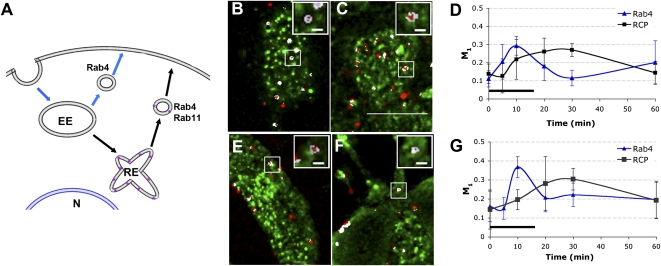Fig. 4.
Trafficking of single groups of 5-HT1A receptors in distinct endosomal pathways measured by QDs. (A) The current model of GPCR recycling includes a short (blue arrows) and a long (black arrows) recycling pathway. Rab4 marks the recyling short pathway; Rab-coupling protein (RCP), which mainly localizes to recycling endosomes (purple), marks the long recycling pathway. EE, early endosomes; N, nucleus; RE, recycling endosome. (B and C) Native receptor recycling (receptors recycle without bound QDs): colocalization between QDs (red) and Rab4 or RCP (green). (B) Rab4 and QD at 10 min. (C) RCP and QD at 30 min. (D) Colocalization between QDs and Rab4 or RCP was quantified using Manders’ coefficient (M1: red pixels overlapping green). Horizontal black bar indicates the duration of 5-HT stimulation. Data are presented as mean ± SD; n = 3–5 image stacks. (E and F) QD-tagged receptor recycling (receptors recycle while bound to QDs): colocalization between QDs (red) and Rab4 or RCP (green). (E) Rab4 and QDs after 10 min. (F) RCP and QDs after 30 min. (G) Colocalization between QDs and Rab4 or RCP was analyzed as described in D. All images are a maximum projection of a z-stack. Insets are 3D projections of boxed QD puncta. White pixels indicate colocalization. (Scale bars: 10 μm in larger images and 1 μm in Insets.)

